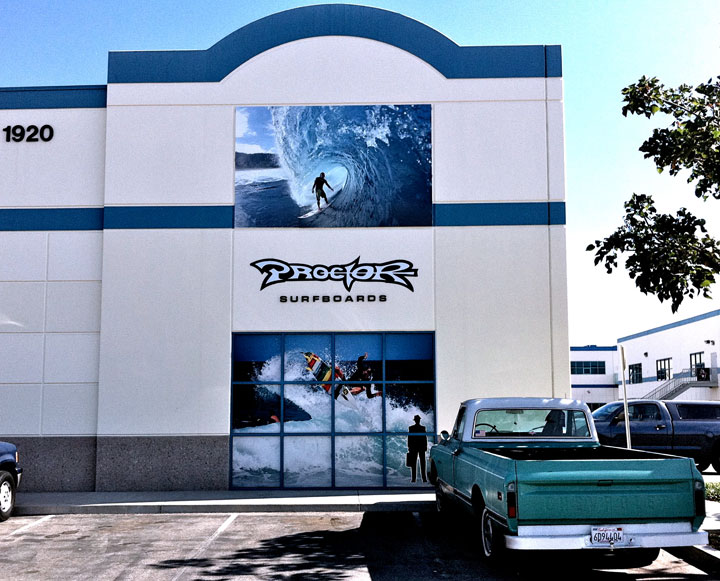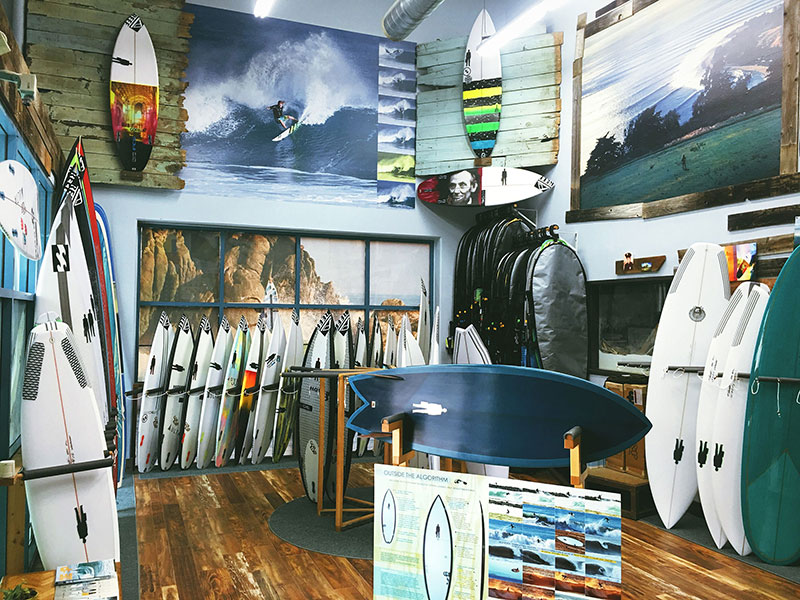Dimensions: 5′5 x 19″ 3/8 x 2″ 3/8 – Five fin convertible – Quad Setup MR-tx (front) GX (rear)
The first time I saw Todd Proctor’s shapes was in one of his Lil Rascal YouTube videos. Jay Phillips was going so fast on that red Lil Rascal at 1st Point Malibu absolutely killing it. One particular scene in that clip which is the most memorable to me was when he passed (literally went around) several loggers who dropped in. The board looked like it had some serious speed yet Jay was still throwing the board around in the pocket.
According to Todd, the Lil Rascal has all the speed of a retro board with the maneuverability and turning of a modern board. Seems too good to be true, huh? Being that I spend a lot of time surfing on the south shore of Oahu, I’ve been looking for a grovelly type board that has enough speed for flatter waves that turns better than the retro twin fins that generate speed in those waves. I’m always searching for the perfect high performance town board that generates speed in crappy waves.
The Lil Rascal 2 is very similar to the original Rascal but has a bit more flip in the nose (which helps to keep it from digging when you hook it in the pocket), shallow parabolic channels (helps create increased lift and speed), and a moon-tail (which Todd says helps shuttle the water off the channels like an exhaust).
The board has a fuller nose and a pulled in tail…it looks way more performance than those speedy twin fins. The deck is flat which creates full rails so even though my board is only 2″ 3/8 thick, it’s 2″ 3/8 thick all the way to the rail which helps with giving you enough bouyancy to paddle into waves early.
This particular Rascal was glassed with custom Proxy (Todd’s special formula epoxy) which provides a board that feels and flexes like poly but lasts 10x longer. The board came out really light and the lime green paint job was solid.
I surfed the Rascal 2 for the first time during my trip to California at shoulder high 1st Point. The waves that day were pretty small with a nice shoulder and immediately new the board was a keeper on the first wave. The Rascal paddled very well for such a small board and one quick pump on the face instantly generated enough speed to get the board racing down the line.
I got my Rascal with a five fin setup and tried it out as a quad first with MR-x twin fins in the front and Gx trailer fins in the rear. Quite an unusual combination for such a small board but that’s what Todd recommended. I thought the board would be too stiff with all the fin area but was pleasantly surprised at the responsiveness. The board is solid on turns and in the pocket with plenty of speed to get around sections. Todd mentioned that the single concave under your front foot creates a little engine providing lift to help generate speed. Anytime I had a little wall the board zipped across the face and then I could finish the end of the wave with a roundhouse cuttie. The Rascal passed the first test, surfing small clean waves without much power or push…I could generate all kinds of speed with a few pumps on the face and to me, surfing small weak waves tells you a lot about your board. If you can have fun in the weaker surf, your board will probably work well when its bigger and better.
With a five fin convertible option, you can ride the Rascal in a variety of conditions…I’ve ridden it with the MR fins and trailer which gives the board more of a twin feeling where the board feels quite skatey. I like this option in sectiony and softer waves though just like any twin, you can’t push too hard on the rail and have to ride the board somewhat flat. Those that like the way tri fins pivot on turns can ride the Rascal as a three fin…I generally ride this board in small surf and find that the twin or quad setup generates more speed for me. Overall I prefer the MR quad setup the best.
I managed to bring the Rascal home to Hawaii in one piece thanks to the packing supplies Todd’s wife Charissa provided me. I took the board out for its first run at Diamond Head on a shoulder to head high day with very clean conditions. This would be a good test to see how the board worked in slightly larger surf. The wave at Diamond Head isn’t very top to bottom but because its more of an open ocean swell, there’s more water behind the wave and it provides you with open faces and long hittable walls.
The board was absolutely on fire going right. A couple quick pumps and the board was screaming across the face. I ended up pumping too much and going past the whole section having to roundhouse to slow down and get back to the pocket. That seemed to be my problem that day, having too much speed and going too far onto the shoulder (not a bad problem to have). The small stubby shape fit the curve of the wave well and turns were crisp…it felt like you could put the board on rail really well and blast your turns.
I also took a few decent waves on my backhand and similar to my forehand, the speed was unbelievable. What really surprised me was how quick it turned off the bottom…I was able to turn hard off the bottom and hook it off the top throwing decent spray 🙂
The Rascal absolutely kills it in peeling waves. It doesn’t matter if it’s waist high, soft, or slow, this board will work if you have any kind of wall. You can take this board out on days when your shortboard isn’t generating enough speed for you to have fun. Some of the town surfers need to try this board and find out how perfect the Lil Rascal is for town.
Neal, SurfboardShack.com
Custom Proxy epoxy Rascal II: 5’5″ x 19 1/4″ x 2 1/4″ moontail
Five fin convertible




